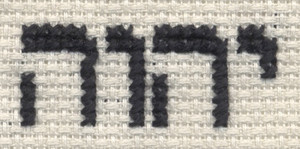
Some participants have expressed concern about the propriety of stitching the Tetragrammaton or others of God’s names.
This response comes from Izzy Pludwinski, our resident Sofer STaM:
“The prohibition is against erasing God’s name – not in writing it. . . There is no problem in writing God’s name if done with a purpose. When one writes God’s name when writing STaM one says “This Name I am writing for the sanctity of the Divine Name (Shem Hashem).
שם זה אני כותב לשם קדושת השם
In STaM if one does not say it then the object ( mezuza, tfillin or Sefer Torah) would be invalid. In stitching there is no object to invalidate, but one should have the proper intention.”
The halachic prohibition is against destroying holy objects that contain any of God’s specified names. That is the reason for consigning such items to a geniza, and ultimately burial in sanctified ground.
Stitchers who want to do a 4-verse section that does not contain any sacred names can make that request in their registration application.


What shall those of us whose verses do contain the tetragramaton do with the paper pattern when we’ve finished stitching if we do not have access to a geniza? Is burial of the paper proper? only in a cemetery or anywhere?
According to our consulting sofer, burial in consecrated ground is reserved for Hebrew holy texts written on parchment by a scribe, used for ritual purposes, and containing any of ten particular names of God. Caution and sometimes superstition or custom have expanded the geniza holdings to include many items that go far beyond that fairly specific principle.
A religious friend took me to the main geniza depot in Jerusalem: a parking lot the size of a football field supporting rows of huge bright pink dumpsters. I saw no Torah scrolls; but there were lots of torn commercially printed books, prayer shawls with tzitzit removed (ie no longer qualified tallitot), even a set of report cards and printer’s proof of a dentist’s business card. These latter two had a brief allusion to Godly intension. Even the Cairo geniza, which has afforded valuable insights into Jewish life, was full of documents – such as tax records – that didn’t belong there.
Like many issues in Judaism, there is no single or definitive answer to your question. The situation has become even more complicated in a digital age, and is again under examination by scholars. None of this directly answers Elaine’s question, and so I advise stitchers to do with the pattern what they would normally do with any book or document in any language that refers to God.
Be assured that even though we are not crafting a real Torah, the finished panels and eventual scroll will be treated respectfully . . . both to honour the work of the participants and to recognize the holy text.
Within the Conservative halacha (I can’t speak for other denominations), my strict-leaning Rabbi (who has Orthodox smicha) tells me that ephemera such as photocopied sheets can be recycled; bound materials such as prayerbooks should be buried.
Nothing with haShem’s name should be mixed with trash or garbage.
=====================
When in doubt, I give my materials to an Orthodox or Conservative rabbi for disposition, and let them decide!